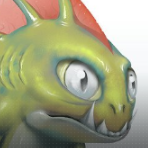-
Posts
2,001 -
Joined
-
Last visited
Reputation Activity
-
 Ben reacted to Ash in Canva
Ben reacted to Ash in Canva
To address some of what is being said on this thread...
Firstly to be clear I'm not a founder, but have been with the company for 25 years. I'm officially appointed as Managing Director of the company, but also use CEO as my title as that is my role in terms of how other countries would view it.
Both Canva and us have made 100% clear we are committing to perpetual licences always being available. That will include V3 or any other future major upgrade of our apps which are released. What's more I will say with Canva's backing we are not under the same financial pressure we would have been to release a V3 anytime soon, meaning those of you using V2 will actually benefit from more features as free updates which may previously have been held back for a V3 if that makes sense. This is of great benefit from an engineering standpoint too as we are far better testing and releasing features in smaller chunks than saving them up to package up as a sellable upgrade.
https://www.canva.com/newsroom/news/affinity-canva-pledge/
https://www.theverge.com/2024/3/27/24113423/affinity-canva-acquisition-pledge-license-price-subscription
https://affinity.serif.com/en-us/press/newsroom/affinity-and-canva-pledge/
As we have made clear there will at some point be a subscription option also which people can take if they choose to. I'm sure there will be additional benefits to that subscription in the future such as asset and document sync, sharing and collaboration and other things which naturally require a subscription as they are features which incur ongoing cost. It may also include other things which can be leveraged with a Canva subscription such as greater stock libraries of images, graphics and fonts. Hopefully that would just be considered reasonable and understandable. There will certainly not be any cynical cutting down of features or limitation of ongoing support in our existing apps just to force a subscription play.
I understand examples of previous acquisitions can make some of you fearful, but they are just historic examples - it has no bearing on what will happen in this case and we are genuinely doing something here which is very different and special. Everything I said on Tuesday, and what both Canva and us pledged yesterday, is 100% true and we are going to stand by it. That includes keeping our entire team here with no layoffs, and continuing to be based in Nottingham.
If you want to believe this or not is up to you, I'm not sure what more we can say at this point to convince those who doubt it. We'll deliver on this over the coming months and years so whatever is being said right now I know it's going to be all good and assuming you are still using Affinity apps you will be happy with how they have developed and that we have continued to be fair and inclusive with our pricing.
Also to follow on from Patricks point - I can take some of the personal attacks on me, but I have to say some of the conduct on this thread with some of you being very quick to attack other community members just because they hold different opinions is really disheartening to see. You can absolutely give your opinion on this deal for sure, and we are happy to leave this as an open forum within reason, but that does mean being courteous to other forum members and not just repeating the same points over and over.
Thanks,
Ash
-
 Ben got a reaction from EricP in Spiral Tool
Ben got a reaction from EricP in Spiral Tool
He came up with that example, because that's what I gave him in way of an explanation.
When using the cusped version, the spiral is formed from straight lines. The partial turn in this case is a percentage of the distance along these straight lines for a single 'turn'. To express this as an angle about a notional centre is less meaningful when the geometry is not an arc. Using an angle would result in non-linear interpolation of the straight line segments.
Note, a 'turn' is a complete lap around, not a segment or arc. Since arc angles (or more accurately, the circle divisor angle) can be arbitrary, a turn is determined as being independent of the arc angle for simplicity. So - you can specify a spiral of 2 turns (a notional rotation of 720 degrees) but then set the arc angle to whatever value gives you the visual result you want.
-
 Ben got a reaction from lepr in Spiral Tool
Ben got a reaction from lepr in Spiral Tool
He came up with that example, because that's what I gave him in way of an explanation.
When using the cusped version, the spiral is formed from straight lines. The partial turn in this case is a percentage of the distance along these straight lines for a single 'turn'. To express this as an angle about a notional centre is less meaningful when the geometry is not an arc. Using an angle would result in non-linear interpolation of the straight line segments.
Note, a 'turn' is a complete lap around, not a segment or arc. Since arc angles (or more accurately, the circle divisor angle) can be arbitrary, a turn is determined as being independent of the arc angle for simplicity. So - you can specify a spiral of 2 turns (a notional rotation of 720 degrees) but then set the arc angle to whatever value gives you the visual result you want.
-
 Ben got a reaction from Sean P in Spiral Tool
Ben got a reaction from Sean P in Spiral Tool
He came up with that example, because that's what I gave him in way of an explanation.
When using the cusped version, the spiral is formed from straight lines. The partial turn in this case is a percentage of the distance along these straight lines for a single 'turn'. To express this as an angle about a notional centre is less meaningful when the geometry is not an arc. Using an angle would result in non-linear interpolation of the straight line segments.
Note, a 'turn' is a complete lap around, not a segment or arc. Since arc angles (or more accurately, the circle divisor angle) can be arbitrary, a turn is determined as being independent of the arc angle for simplicity. So - you can specify a spiral of 2 turns (a notional rotation of 720 degrees) but then set the arc angle to whatever value gives you the visual result you want.
-
 Ben got a reaction from Patrick Connor in Spiral Tool
Ben got a reaction from Patrick Connor in Spiral Tool
He came up with that example, because that's what I gave him in way of an explanation.
When using the cusped version, the spiral is formed from straight lines. The partial turn in this case is a percentage of the distance along these straight lines for a single 'turn'. To express this as an angle about a notional centre is less meaningful when the geometry is not an arc. Using an angle would result in non-linear interpolation of the straight line segments.
Note, a 'turn' is a complete lap around, not a segment or arc. Since arc angles (or more accurately, the circle divisor angle) can be arbitrary, a turn is determined as being independent of the arc angle for simplicity. So - you can specify a spiral of 2 turns (a notional rotation of 720 degrees) but then set the arc angle to whatever value gives you the visual result you want.
-
 Ben reacted to JET_Affinity in How To Reset The Bounding Box In Designer...
Ben reacted to JET_Affinity in How To Reset The Bounding Box In Designer...
I've said this before in other threads, but it is pertinent to this thread, too. so...
Every serious vector-based illustration program should provide for transforming selections disproportionally in any direction needed, not just horizontally and vertically.
So first, it is a very good thing that Affinity bounding boxes 'remember' their contents' rotation. Since Affinity does not provide transform tools, but only provides transform handles on bounding boxes, that is the only way to perform on-page scaling in directions other than vertical and horizontal. Yes, I agree that one should be able to permanently re-set an object's to page-normal when desired, but a rotated bounding box is a very useful thing.
Inkscape, for one example, insists on all bounding boxes always being page-normal. So when you need to scale a rotated selection in the direction of its rotated orientation, you have to 'un-rotate' it so that the desired direction of scaling is either horizontal or vertical, perform the scaling, and then re-rotate it to its intended orientation. That's needlessly tedious.
But Affinity's treatment is still senselessly limited. Consider an object that is rotated 35 degrees. Its rotated bounding box is 'remembered'. So you can disproportionately scale it in either the 35 degree or 125 degree directions. But by what logic is it assumed that the illustrator does not need to scale the rotated object in some other direction that is pertinent and meaningful to the illustration.
Affinity bounding boxes provide an absurdly redundant FIVE rotation handles! One of them already has a different visual treatment: the 'lollypop' handle. Give that handle a practical and useful difference: Enable it to rotate the bounding box around the selection when a modifier key is pressed, thereby enabling the illustrator to 'aim' the transform handles in whatever direction needed, relative to the selection.
JET
-
 Ben got a reaction from mark117h in Spiral Tool
Ben got a reaction from mark117h in Spiral Tool
Yes - the construction for a Phi spiral would be fundamentally different to Fibonacci. The Fibonacci we build from the centre following the sequence. A Phi spiral would be a constant scaling from the outside. I'll have a think.
Actually - try using the Decaying spiral, set "Decay per segment" and use 100-(100/phi) for the Decay value. I could probably add this as a preset.
We do have a continuous spiral - it's the plotted one. Each point is correctly placed. Currently it's line segments only (though you can increase that to add accuracy). If I can figure out the maths for correct(ish) curve segments I'll add it.
-
 Ben got a reaction from Rudolphus in Spiral Tool
Ben got a reaction from Rudolphus in Spiral Tool
I can look into on-canvas controls, but not all values/properties can be easily represented with a control point.
-
 Ben got a reaction from Rudolphus in Spiral Tool
Ben got a reaction from Rudolphus in Spiral Tool
Yes - the construction for a Phi spiral would be fundamentally different to Fibonacci. The Fibonacci we build from the centre following the sequence. A Phi spiral would be a constant scaling from the outside. I'll have a think.
Actually - try using the Decaying spiral, set "Decay per segment" and use 100-(100/phi) for the Decay value. I could probably add this as a preset.
We do have a continuous spiral - it's the plotted one. Each point is correctly placed. Currently it's line segments only (though you can increase that to add accuracy). If I can figure out the maths for correct(ish) curve segments I'll add it.
-
 Ben got a reaction from jc4d in Spiral Tool
Ben got a reaction from jc4d in Spiral Tool
Yes - the construction for a Phi spiral would be fundamentally different to Fibonacci. The Fibonacci we build from the centre following the sequence. A Phi spiral would be a constant scaling from the outside. I'll have a think.
Actually - try using the Decaying spiral, set "Decay per segment" and use 100-(100/phi) for the Decay value. I could probably add this as a preset.
We do have a continuous spiral - it's the plotted one. Each point is correctly placed. Currently it's line segments only (though you can increase that to add accuracy). If I can figure out the maths for correct(ish) curve segments I'll add it.
-
 Ben got a reaction from ronnyb in Spiral Tool
Ben got a reaction from ronnyb in Spiral Tool
Yes, because it is the only curved spiral that finishes in the centre of the shape - all other curved spirals have a non-centred end. The plotted one achieves this (currently) at the expense of it using straight lines to link the procedurally placed points.
-
 Ben got a reaction from ronnyb in Spiral Tool
Ben got a reaction from ronnyb in Spiral Tool
Yes - the construction for a Phi spiral would be fundamentally different to Fibonacci. The Fibonacci we build from the centre following the sequence. A Phi spiral would be a constant scaling from the outside. I'll have a think.
Actually - try using the Decaying spiral, set "Decay per segment" and use 100-(100/phi) for the Decay value. I could probably add this as a preset.
We do have a continuous spiral - it's the plotted one. Each point is correctly placed. Currently it's line segments only (though you can increase that to add accuracy). If I can figure out the maths for correct(ish) curve segments I'll add it.
-
 Ben got a reaction from Benfischer in Spiral Tool
Ben got a reaction from Benfischer in Spiral Tool
I can look into on-canvas controls, but not all values/properties can be easily represented with a control point.
-
 Ben got a reaction from loukash in Spiral Tool
Ben got a reaction from loukash in Spiral Tool
I can look into on-canvas controls, but not all values/properties can be easily represented with a control point.
-
 Ben got a reaction from Aammppaa in Spiral Tool
Ben got a reaction from Aammppaa in Spiral Tool
I can look into on-canvas controls, but not all values/properties can be easily represented with a control point.
-
 Ben got a reaction from Return in Spiral Tool
Ben got a reaction from Return in Spiral Tool
I can look into on-canvas controls, but not all values/properties can be easily represented with a control point.
-
 Ben got a reaction from tzvi20 in Spiral Tool
Ben got a reaction from tzvi20 in Spiral Tool
I can look into on-canvas controls, but not all values/properties can be easily represented with a control point.
-
 Ben got a reaction from Mithferion in Spiral Tool
Ben got a reaction from Mithferion in Spiral Tool
I can look into on-canvas controls, but not all values/properties can be easily represented with a control point.
-
 Ben got a reaction from Benfischer in Spiral Tool
Ben got a reaction from Benfischer in Spiral Tool
Yes - the construction for a Phi spiral would be fundamentally different to Fibonacci. The Fibonacci we build from the centre following the sequence. A Phi spiral would be a constant scaling from the outside. I'll have a think.
Actually - try using the Decaying spiral, set "Decay per segment" and use 100-(100/phi) for the Decay value. I could probably add this as a preset.
We do have a continuous spiral - it's the plotted one. Each point is correctly placed. Currently it's line segments only (though you can increase that to add accuracy). If I can figure out the maths for correct(ish) curve segments I'll add it.
-
 Ben got a reaction from Frozen Death Knight in Spiral Tool
Ben got a reaction from Frozen Death Knight in Spiral Tool
Yes - the construction for a Phi spiral would be fundamentally different to Fibonacci. The Fibonacci we build from the centre following the sequence. A Phi spiral would be a constant scaling from the outside. I'll have a think.
Actually - try using the Decaying spiral, set "Decay per segment" and use 100-(100/phi) for the Decay value. I could probably add this as a preset.
We do have a continuous spiral - it's the plotted one. Each point is correctly placed. Currently it's line segments only (though you can increase that to add accuracy). If I can figure out the maths for correct(ish) curve segments I'll add it.
-
 Ben got a reaction from pruus in Spiral Tool
Ben got a reaction from pruus in Spiral Tool
Yes - the construction for a Phi spiral would be fundamentally different to Fibonacci. The Fibonacci we build from the centre following the sequence. A Phi spiral would be a constant scaling from the outside. I'll have a think.
Actually - try using the Decaying spiral, set "Decay per segment" and use 100-(100/phi) for the Decay value. I could probably add this as a preset.
We do have a continuous spiral - it's the plotted one. Each point is correctly placed. Currently it's line segments only (though you can increase that to add accuracy). If I can figure out the maths for correct(ish) curve segments I'll add it.
-
 Ben got a reaction from Mithferion in Spiral Tool
Ben got a reaction from Mithferion in Spiral Tool
Yes - the construction for a Phi spiral would be fundamentally different to Fibonacci. The Fibonacci we build from the centre following the sequence. A Phi spiral would be a constant scaling from the outside. I'll have a think.
Actually - try using the Decaying spiral, set "Decay per segment" and use 100-(100/phi) for the Decay value. I could probably add this as a preset.
We do have a continuous spiral - it's the plotted one. Each point is correctly placed. Currently it's line segments only (though you can increase that to add accuracy). If I can figure out the maths for correct(ish) curve segments I'll add it.
-
 Ben got a reaction from GRAFKOM in Spiral Tool
Ben got a reaction from GRAFKOM in Spiral Tool
Yes - the construction for a Phi spiral would be fundamentally different to Fibonacci. The Fibonacci we build from the centre following the sequence. A Phi spiral would be a constant scaling from the outside. I'll have a think.
Actually - try using the Decaying spiral, set "Decay per segment" and use 100-(100/phi) for the Decay value. I could probably add this as a preset.
We do have a continuous spiral - it's the plotted one. Each point is correctly placed. Currently it's line segments only (though you can increase that to add accuracy). If I can figure out the maths for correct(ish) curve segments I'll add it.
-
 Ben got a reaction from Ash in Spiral Tool
Ben got a reaction from Ash in Spiral Tool
Yes - the construction for a Phi spiral would be fundamentally different to Fibonacci. The Fibonacci we build from the centre following the sequence. A Phi spiral would be a constant scaling from the outside. I'll have a think.
Actually - try using the Decaying spiral, set "Decay per segment" and use 100-(100/phi) for the Decay value. I could probably add this as a preset.
We do have a continuous spiral - it's the plotted one. Each point is correctly placed. Currently it's line segments only (though you can increase that to add accuracy). If I can figure out the maths for correct(ish) curve segments I'll add it.
-
 Ben got a reaction from tymcat in Scaling line length - Designer as a basic CAD application
Ben got a reaction from tymcat in Scaling line length - Designer as a basic CAD application
This is something we are aware of.
Not saying much more than that just now......














